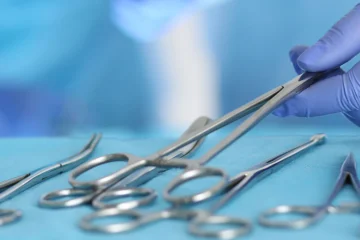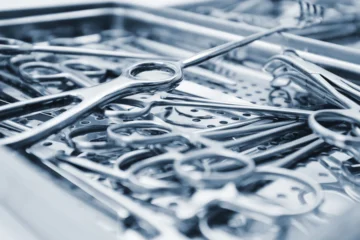Surgical scissors are essential tools used in various medical procedures to cut tissues, sutures, and other materials with precision and accuracy. With a wide range of types and designs available, it’s important to understand the different options, their uses, and how to properly maintain them for optimal performance. In this comprehensive guide, we will explore the types of surgical scissors, their uses in different medical specialties, and best practices for maintenance.
Understanding Surgical Scissors
Surgical scissors are handheld cutting instruments used by surgeons, nurses, and other medical professionals during surgical procedures. They are designed to cut and dissect tissues, sutures, and other materials with precision and control. Surgical scissors are available in a variety of types, sizes, and designs, each suited for specific tasks and procedures.
Types of Surgical Scissors:
- Operating Scissors: Operating scissors are general-purpose scissors used for cutting tissue, sutures, and other materials during surgical procedures. They are available in various sizes and designs, including straight, curved, sharp-blunt, and blunt-blunt.
- Dissecting Scissors: Dissecting scissors are designed for more delicate dissection and cutting of tissues, blood vessels, and other structures. They feature finer tips and sharper blades than operating scissors, allowing for more precise cutting and dissecting.
- Tissue Scissors: Tissue scissors are specifically designed for cutting soft tissues such as skin, muscle, and organs. They feature sharp, pointed blades that allow for precise and clean cutting of tissues without causing trauma or damage to surrounding structures.
- Suture Scissors: Suture scissors, also known as stitch scissors, are designed for cutting sutures and other materials used to close wounds. They feature small, sharp blades with a curved or straight design for easy access to suture sites.
- Microsurgical Scissors: Microsurgical scissors are designed for use in microsurgery and other delicate procedures that require precision and accuracy. They feature extremely fine tips and sharp blades that allow for precise cutting and dissecting of small tissues and blood vessels.
Uses of Surgical Scissors
Surgical scissors are used in various medical specialties and procedures, including:
1. General Surgery:
- Tissue Dissection: Surgical scissors are used to dissect and cut tissues, blood vessels, and other structures during general surgical procedures such as appendectomies, cholecystectomies, and bowel surgeries.
2. Orthopedic Surgery:
- Bone and Soft Tissue Surgery: Surgical scissors are used to cut soft tissues such as muscles, tendons, and ligaments during orthopedic procedures such as joint replacements, fracture repairs, and tendon repairs.
3. Plastic Surgery:
- Tissue Dissection and Reconstruction: Surgical scissors are used to dissect and shape tissues during plastic and reconstructive surgeries such as facelifts, breast reconstructions, and rhinoplasties.
4. Ophthalmic Surgery:
- Eye Tissue and Suture Cutting: Surgical scissors are used to cut delicate eye tissues and sutures during ophthalmic procedures such as cataract surgeries, corneal transplants, and retinal surgeries.
5. Cardiothoracic Surgery:
- Vascular and Tissue Dissection: Surgical scissors are used to dissect and cut blood vessels, tissues, and structures during cardiothoracic procedures such as coronary artery bypass grafting (CABG), valve replacements, and lung surgeries.
Maintenance of Surgical Scissors
Proper maintenance is essential to ensure the longevity and performance of surgical scissors. Follow these best practices for maintenance:
1. Cleaning:
- Immediate Cleaning: Clean surgical scissors immediately after use to prevent blood, tissue, and other debris from drying and adhering to the blades.
- Use Enzymatic Cleaners: Use enzymatic cleaners or detergents specifically designed for surgical instruments to remove organic debris and stains.
- Avoid Harsh Chemicals: Avoid using harsh chemicals, abrasive cleaners, or steel wool, as they can damage the blades and reduce the effectiveness of the scissors.
2. Sterilization:
- Autoclaving: Sterilize surgical scissors using steam autoclaving or other sterilization methods recommended by the manufacturer.
- Follow Manufacturer’s Instructions: Follow the manufacturer’s instructions for sterilization, including temperature, pressure, and cycle times, to ensure effective sterilization without damaging the scissors.
3. Lubrication:
- Regular Lubrication: Apply a thin layer of instrument lubricant to the screw joint and cutting edges of the scissors regularly to prevent corrosion and ensure smooth operation.
- Avoid Excess Lubrication: Avoid over-lubricating the scissors, as excess lubricant can attract dust, debris, and contaminants.
4. Inspection:
- Regular Inspection: Inspect surgical scissors regularly for signs of damage, wear, or corrosion, including bent or dull blades, loose screws, and rust spots.
- Replace Damaged Scissors: Replace any scissors that are damaged, worn, or no longer functioning properly to ensure safe and effective use.
5. Storage:
- Dry Storage: Store surgical scissors in a clean, dry environment to prevent corrosion and contamination.
- Avoid Contact with Other Instruments: Store surgical scissors separately from other instruments to prevent damage to the blades and cutting edges.
Conclusion
Surgical scissors are essential tools used in various medical procedures to cut tissues, sutures, and other materials with precision and accuracy. By understanding the different types of surgical scissors available, their uses in different medical specialties, and best practices for maintenance, you can ensure optimal performance and longevity of these important instruments. Proper care and maintenance of surgical scissors are essential to ensure safe and effective use and to protect the integrity of the instruments for years to come. With the right knowledge and practices, surgical scissors can continue to provide reliable performance and contribute to successful surgical outcomes.


